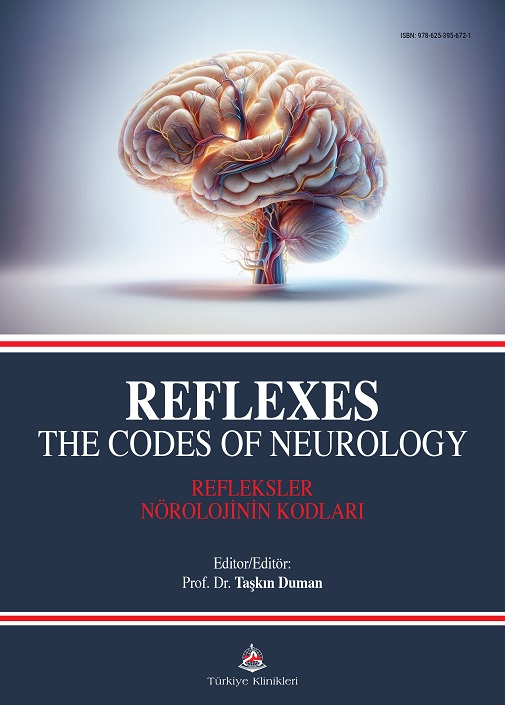Reflexes, as rapid, dynamic, and predictable responses, offer invaluable insights into the functioning and dysfunctions of the neural system. These responses, which can be elicited in a simple manner, contain uniquely valuable data for deciphering the complexities of the nervous system. Such data can help determine the location of lesions, provide localization diagnoses by considering the neuroanatomical basis of reflex changes, and offer critical guidance in the diagnosis, follow-up, and treatment processes of neurological disorders caused by various factors. By analyzing the characteristics of reflex alterations, essential interpretations regarding the nature of the underlying pathology can be made. The fact that reflexes change throughout different stages of life, starting from the newborn period, makes them a unique biological parameter for monitoring development and age-related changes.
understanding reflexes is not merely an academic endeavor— it is one of the starting points for grasping the magnificent structure, fascinating functioning, unique features, complexity, and profound adaptability of the nervous system. When viewed from a broader perspective, the presence, absence, symmetry or asymmetry, attenuation, exaggeration, temporal variation, or subtle changes in other qualities of reflex responses carry meanings far beyond being mere data in a neurological examination. grasping reflexes holds fundamental importance in evaluating the structure and functioning of the nervous system. Even changes in reflex amplitude alone can serve as critical indicators of underlying neurological pathology, enabling the exclusion or confirmation of key items in our differential diagnosis list. understanding and assessing the nuances of reflex responses is considered a hallmark of expertise in neurological practice.
One of the most unforgettable moments in a neurologist’s life is when they first hold a reflex hammer and witness a reflex response. Throughout their professional journey, understanding, assessing, and interpreting reflexes remain among their principal endeavors. It is hoped that the knowledge contained in these pages will contribute to the pursuit of mastery in reflexes.
In the beginning, early observations based on philosophical inquiry and primitive anatomical knowledge paved the way for comprehensive systematic research, leading to the formation of the knowledge we possess today regarding reflexes. We remember with gratitude the thinkers, researchers, clinicians, and scientists who contributed to laying the foundational stones of our current understanding of reflexes. Their dedication to science and humanity has made the information presented in these pages possible.
The idea that reflexes deserve to be the subject of a book in their own right is the foundational inspiration for this work. With the hope that this book may contribute a step forward in the dynamic journey of neurological sciences driven by research and learning toward a deeper understanding of reflexes.
Prof. Dr. Taşkın Duman
Hatay Mustafa Kemal University Hospital,
Department of Neurology,
Hatay, Türkiye
Bölümler
SECTION 01
Section Editor/Kısım Editörü: Taşkın DUMAN
01 | The Concept of Reflex
Taşkın DUMAN, Ali Özhan SIVACI
02 | General Overview of Reflexes
Ali Özhan SIVACI
03 | Neuroanatomy and Neurophysiology of Reflexes
Muhammet Okay ÖRÜN
04 | Reflex Examination: Physiological and Pathological Findings
Aydan KÖYSÜREN
05 | Interpretation of Reflex Responses and Clinical Evaluation
Özlem AKSOY ÖZMENEK
SECTION 02
Section Editor/Kısım Editörü: Asuman ÇELİKBİLEK
06 | Superficial Reflexes
Selcen DURAN
07 | Superficial Reflexes Induced by Stimulation of Mucosal Surfaces
Burç Esra ŞAHİN
08 | Tendon Reflexes
Asuman ÇELİKBİLEK
09 | Midbrain and Brainstem Reflexes
Esra TAŞKIRAN
10 | Spinal Reflexes
Tuğba ÇALIŞIR
SECTION 03
Section Editor/Kısım Editörü: Şevki TAHİN
11 | Postural Reflexes and Control of Movement
Gülgün UNCU
12 | Autonomous and Visceral Reflexes
Fahrettin EGE
13 | Ocular Reflexes
Nazlı Gamze BÜLBÜL
14 | Acoustic Reflexes
Pınar ATABEY
15 | Vestibular Reflexes
Aysu YETİŞ
SECTION 04
Section Editor/Kısım Editörü: Füsun MAYDA DOMAÇ
16 | Pathological Reflexes
Derya YAVUZ DEMİRAY
17 | Examples of Reflex Changes Identified in Diseases
Dursun CEYLAN
18 | Electrophysiological Reflexes in Neurology and Their Applications
Aslıhan BARAN
19 | Reflexes in Developmental Assessment
Ülgen YALAZ TEKAN
20 | Reflexes in Disorders of Consciousness
İpek GÜNGÖR DOČAN



